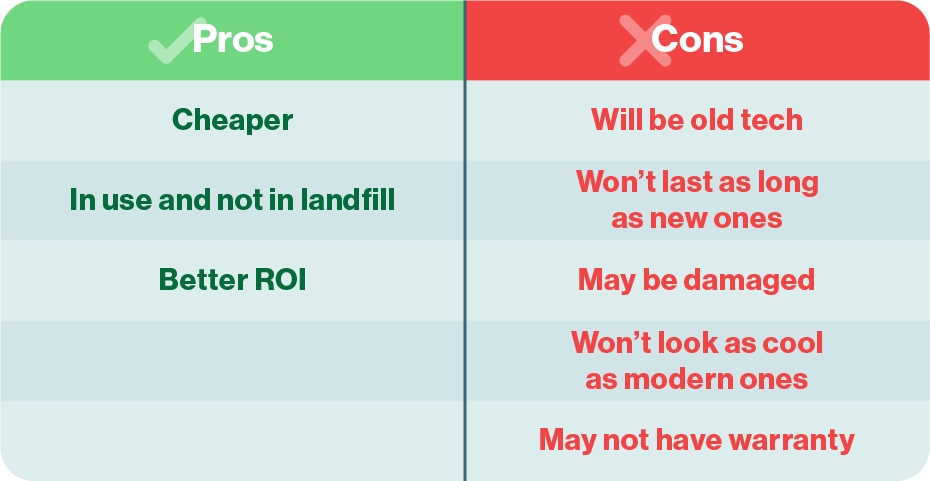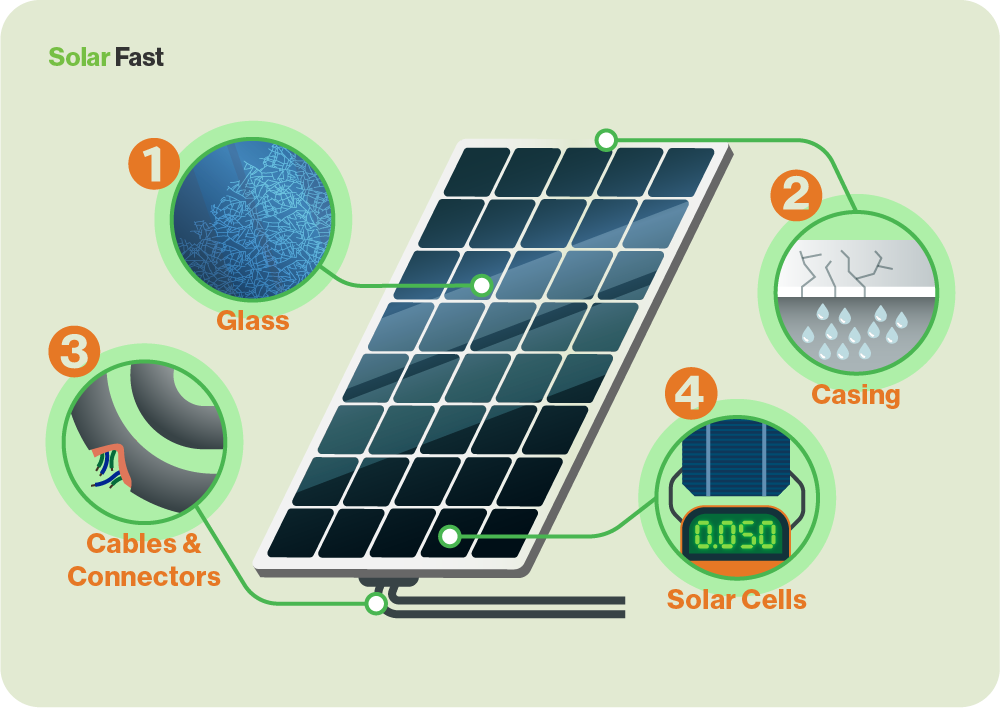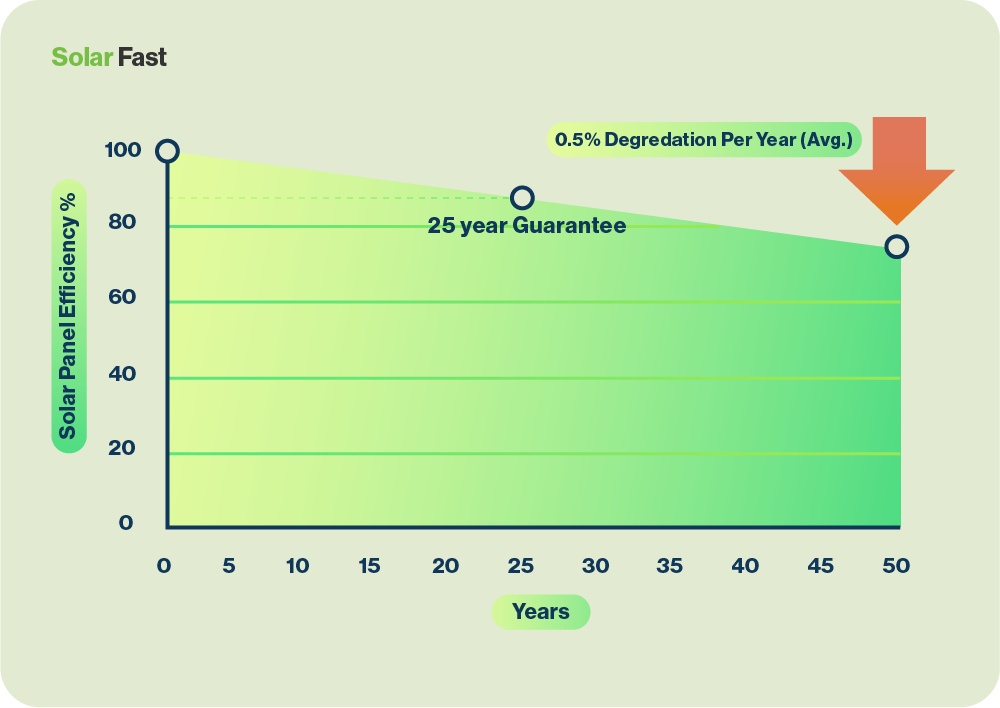‘Second-hand solar panels?!?!’ I hear you mumble, but it’s not a daft idea when you think about it.
The part of a solar system that lasts the longest is the solar panels – they have no moving parts and need hardly any maintenance at all.
They ‘degrade’ over time, but it takes about 25 years to lose just 20% of their overall efficiency, so they will still produce electricity for decades.
Pros and Cons of buying used solar panels
The pros and cons of second-hand solar panels are pretty apparent as soon as the idea of bagging some cheap electricity enters your head:

Will second-hand panels work?
They sure will, they will just work less well as the years go by.
Solar panels are constructed very simply – coated or rust-proof metal for the casing, glass for the covers and the aforementioned PV cells for the electricity.
On top of that, there are cables and the connectors which are only generally moved once and that’s when the panels are installed.
Short of physical damage there isn’t a great deal that can go wrong with a solar panel.
What to look out for when buying second-hand panels
So, what do you have to look out for when buying second-hand panels?
The cosmetic state of the panel will be a good indication of its usefulness, but you will have to check each panel with a multi-meter too.

Glass
To protect the PV cells, and allow the light to get to them, the top of a solar panel’s case is made from toughened safety glass.
This is unlikely to get smashed or damaged unless something hits it – which isn’t a thing that generally happens on your roof.
The glass will start to get micro-cracks in it as the years go by due to it expanding and contracting as the panels heat up and cool down.
The micro cracks act like tiny diffusers, splitting the light and sending it away from the PV cells.
So, just check the surface of the glass to see if it looks ‘crazed’.
Casing
The casing needs to be waterproof, that’s about it really.
Just make sure there are no cracks in the casing, especially around the corners where damage and decay would be most likely to appear.
Water and condensation within the case is also something to look for, this will indicate water ingress that could cause short circuits and reduce the efficiency of the panels.
Cables and Connectors
It is very unlikely that the internal connections would be damaged on a second-hand solar panel as the case gives plenty of protection.
Again it’s damage that you need to look for, anything that could have worked through the case to physically break a cell or the connections between them.
The cables on the outside, however, are much more likely to get damaged as they are subject to the elements and are the only parts of the panel that can be connected and disconnected.
The cables are usually connected using MC4 connectors which are easily replaceable.
Solar Cells
Obviously the most important part of the solar panel is the PV solar cells as they make all that power for you.
They do degrade, as we have said, but as it’s only at a rate of 0.1% a year, most panels will be producing something.
Easy way to test in the panels are still producing is take them into the garden on a sunny day and angle them towards the sun.
Then take a multi-meter and attach the probes to the negative and positive cables coming out of the casing.
Make sure the multi-meter is set to volts and that’ll show you what power the panel is producing.
Can I get other solar equipment second-hand?
Yes, you can certainly buy ‘pre-loved’ solar equipment – and you’ll need it if you want to make your own electricity.
Inverters and batteries are not quite as easy to test but their age is a good indicator of if they are worth your money.
Warranties on both these items are usually 10 years, so you should be looking at equipment that is around 5 years old if you want good use out of it.
You can test a battery with the handy multi-meter you tested the panels with.
Batteries should hold the same voltage as they state on the side, or at least around that number, if they don’t then it’s best to avoid them.
Who would buy my second-hand solar stuff?
If your system is coming to the end of its life and you’re looking to replace it with more modern equipment, there are plenty of ways to sell your equipment to avoid it going to the local recycling centre.
Solar farms and parks are sometimes in the market for used solar equipment.
The fact they are on a much larger scale means they can easily take advantage of slightly less efficient panels – going for quantity over quality.
Solar Farms are good shout for batteries too as they become more usable when hooked up to lots of other batteries.
There are also 100s of solar groups on social media, message boards dedicated to DIY solar and enthusiast clubs all over the world.
Failing all that, just hit Facebook Marketplace, Ebay or Gumtree!
Fitting a second-hand solar system
Fitting your own DIY domestic solar system is not a great idea unless you are a qualified electrician and are familiar with all rules and regulations pertaining to domestic electricity.
If you are looking to feed anything back into the grid, your system will have to be MCS registered – meaning it must be fitted by an MCS registered installer.
If you’re just looking to get the garden room independently powered, then you can probably have a crack at doing it yourself.
Just be careful and don’t do anything you aren’t 100% certain about.
How long do solar panels last?
There are no moving parts in a solar panel so very little can go wrong with them.
Each PV cell is made from purified silicon inlayed with a conducting material.
When the daylight (photons) hits each cell it ‘jiggles’ the molecules around inside and that creates the electricity.
As this is the only movement in a solar panel, you will never have to replace any parts or cells as the years go by.
The silicon cells themselves will degrade by 0.1% a year and, after 2 decades, will still be producing 80% of the electricity they did when they were new.
So, to answer the ‘How long do solar panels last?’ question, we say 25 years if you are using them in a normal, domestic installation … or 50 years if you are making your own DIY system. Our solar panels now have a 30-year performance warranty.

Costs of used solar panels
The cost of a second-hand solar panel will vary as much as new ones do depending on what kind of panels they are and how much power they originally produced.
Between £50 and £75 is about average for panels between 150 W and 300 W, but shopping around or buying in bulk will reduce that cost considerably.







